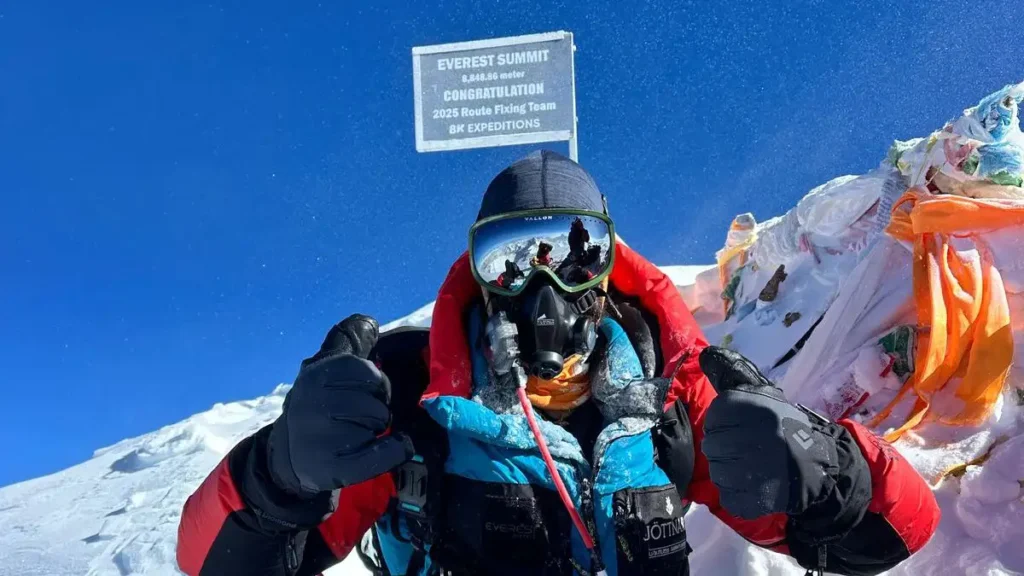Ex-Military Friends Aim to Conquer Everest in a Week — With a Scientific Edge
Climbing Mount Everest is widely regarded as one of the toughest physical and mental challenges on Earth. Most climbers take several weeks to acclimatize to the thin air, enduring harsh weather and slow ascents. But four former British soldiers have set out to rewrite the rules. Their goal? To summit the world’s highest peak — all 8,849 metres — in just seven days using a surprising scientific tool: xenon gas.

This team of ex-military men plans to combine their elite training with a cutting-edge technique that could change the future of extreme-altitude climbing.
Meet the Climbers
The team consists of four UK veterans, each with years of experience in high-pressure situations. Their backgrounds include military deployments, survival training, and mountaineering. This mission marks their boldest challenge yet — a fusion of physical endurance and scientific innovation.
Their plan involves more than just speed. They’re also testing how xenon gas, typically used in medicine, might help climbers adapt faster to low-oxygen conditions.
What Is Xenon and Why Use It?
Xenon is a rare, colorless gas often used as a general anaesthetic in hospitals. Recent research shows it can do more than sedate patients — it may also stimulate the production of erythropoietin (EPO), a hormone that boosts red blood cell levels. More red blood cells mean more oxygen delivered to muscles and organs, which is vital at high altitudes.
By inhaling small doses of xenon before and during their climb, the team hopes to simulate the effects of weeks of acclimatization in a much shorter time. Early lab tests and altitude training sessions already revealed promising results, including better endurance and quicker recovery.
A Fast Ascent Strategy
Climbers typically spend six to eight weeks adjusting to Everest’s altitude. But these veterans plan to complete the round trip from base camp to summit and back in just one week.
They’ve already undergone xenon conditioning before arriving in Nepal. Their ascent will follow a fast-track route designed for efficiency and supported by experienced Sherpas. Although they’ll still carry supplemental oxygen at higher elevations, they expect xenon to give them an edge — especially in terms of energy, oxygen use, and stamina.
They designed every part of the climb with precision, factoring in health monitoring, logistics, and safety protocols to balance risk with ambition.
Military Precision Meets Scientific Innovation
What sets this expedition apart is the combination of military discipline and scientific research. The team’s mental toughness, developed through years of service, forms a strong foundation. But they’re also relying on a deeper understanding of human physiology, using technology to explore new limits.
Their mission isn’t just personal. It could open the door for new ways to tackle high-altitude environments — not just for adventurers, but for soldiers, rescue teams, and astronauts who often operate in low-oxygen conditions.
Managing the Risks
Climbing Everest always involves risk. Rapid ascents can lead to serious altitude illnesses like acute mountain sickness (AMS), high-altitude pulmonary edema (HAPE), and cerebral edema, which can be fatal if untreated. The team understands the dangers and has taken every step to minimize them.
Doctors and researchers will monitor their vitals closely, and their climb includes contingency plans for emergencies. They’re also following strict medical guidelines for xenon usage to ensure safety throughout the expedition.
Could This Redefine High-Altitude Climbing?
If the climb succeeds, the implications could reach far beyond this one mission. Xenon might become a valuable tool in reducing acclimatization time for mountaineers and people working in extreme environments. The approach could help medical teams respond faster to emergencies in high-altitude regions or prepare soldiers for operations in mountainous terrain.
The expedition also contributes to broader scientific research. The results may help shape future studies into performance, endurance, and oxygen adaptation — not just for climbers but for athletes and professionals in many fields.
Not Just Another Summit
For these four ex-military friends, this journey isn’t about breaking records — it’s about challenging the limits of human endurance using science, strategy, and teamwork. They believe that with the right preparation and mindset, innovation can push the boundaries of what the human body can achieve.
Whether they reach the summit in seven days or face unexpected setbacks, their expedition will provide valuable insights. Their mission highlights how curiosity, courage, and collaboration can lead to discoveries that benefit far more than just one group of climbers.






